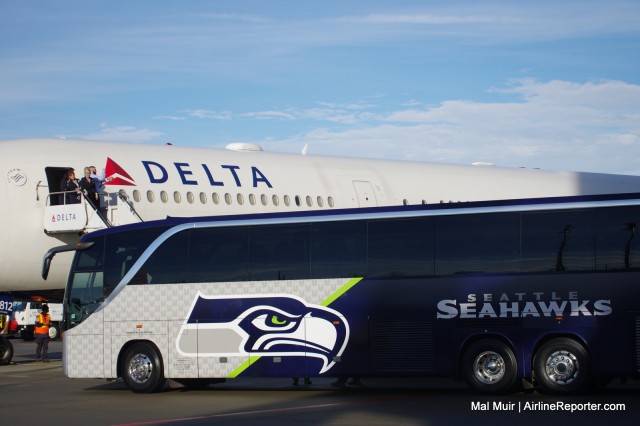
A Delta plane getting boarded by the Seahawks as they head to Phoenix for the Super Bowl
Sunday morning in Seattle, people should be drinking their morning coffee, reading a paper (or this site, obviously) or going for a morning run. But when the Seahawks are headed for the Super Bowl, the city takes on a different vibe. Streets are lined with people along the drive from the team’s offices and training facility at the Virginia Mason Athletic Center (VMAC) in Renton, to SeaTac for their journey to Phoenix.
The airport was surrounded by fans, family, and friends of airport staff who were plane-side to wave farewell. But their departure leads to a bigger, more important, question for AvGeeks: who, and what, were they flying?
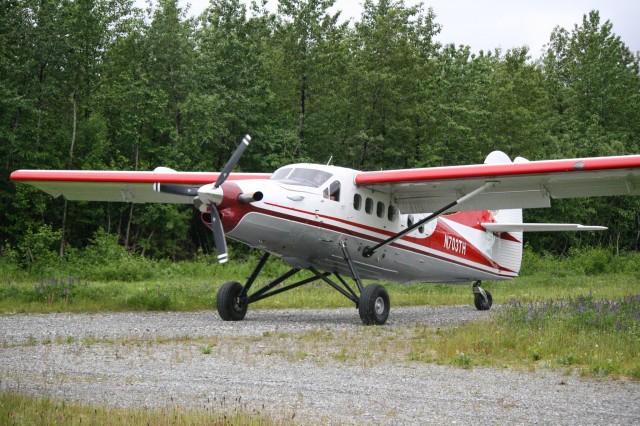
The Yakutat Coastal Airlines de Havilland Otter – Photo: David Delagarza
Having recently embarked on a fair number of adventures around the world, one of the questions I sometimes get asked is what my favorite airline is. No one expects the answer: Yakutat Coastal Airlines.
Never heard of them? I’d be surprised if you had. Their fleet is pretty limited, at two aircraft, and they only have one full-time pilot, Hans Munich. The passenger experience is a bit different as well. The seats are uncomfortable. There is no food or drink available on board. You even have to load your own luggage into the hold. But you’re not going to find many others operating the charter routes they do, and the in-flight views couldn’t be any better.
Our flight was the culmination of a grand adventure my wife and I took, along with a small group of friends, in the summer of 2012. The main reason for the trip was a twelve-day whitewater rafting trip on the Tatshenshini and Alsek rivers through Glacier Bay National Park (Alaska), Kluane National Park and Preserve (Yukon Territory), and Tatshenshini-Alsek Park (British Columbia.)
Just getting to the starting point of the rafting trip was a logistical adventure in and of itself. It all started with a Southwest Airlines flight from Denver to Seattle, followed by an Alaska Airlines flight to Juneau, Alaska. Then, we hopped on the Alaska State Ferry for a spectacular four-hour trip up the Lynn canal to the small town of Haines.
In Haines, we stocked up on food, rented rafts and other gear, and hired transport for the final 100-mile drive to to the north. Our launch point into the wilderness was at the end of a rough road in Yukon Territory, at a place called Dalton Post. We spent 12 days on the Tatshenshini and Alsek rivers running rapids, watching Bald Eagles soar overhead, embarking on some magnificent hikes, and trying to avoid grizzly bears.
The last few days of the trip brought us over the international boundary and into Glacier Bay National Park, where we had the opportunity to get up close and personal with glaciers. The highlight of the river trip was floating on Alsek Lake, surrounded by dozens of towering icebergs. Once we reached the end of the river trip at Dry Bay, there was no road to greet us – a grass landing strip was our only connection back to civilization.

My travel map for the USA… Could I tick an extra state off that list? – Image: TravBuddy.com
Each year I set some travel goals for myself; that way throughout all the craziness that may happen during the year, I have a guideline of the things I want to see or do. OshKosh was on my list, as well as my trip home to Australia back in April. I was able to complete those and needed some additional challenges.
I realized fairly late in the year, after returning from New Zealand, that I had left a goal off my list. Being new to living in the USA, I want to see more of this country that I now call home. I had set a goal to add at least one more state to my list of those visited (I was sitting at 42 and I decided that I wanted to make it to at least 43 by the new year).
My colleagues at Airline Reporter found out about this and thought they would have a bit of fun with it. I could check off a state, but I had to do it for less than $100 and make a whole weekend out of it. I accepted the challenge.
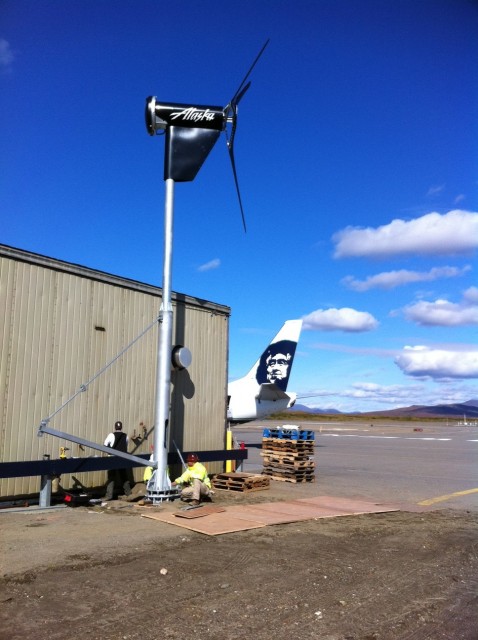
Wind power for Alaska Airlines up in Nome, Alaska. Photo from Alaska Airlines.
So where the heck is Nome, Alaska? It is pretty darn as close to the middle of no where as you can get, although it is on the western edge of Alaska. It is a small town of less than 4,000 people and transportation to destinations outside the city is difficult to come by. Roads connect Nome to smaller cities up to 54 miles away, but there are no roads connecting the city to the rest of the world. For the town to operate, it requires transportation via water and air.
Air travel becomes a necessity to get goods and people to and from remote areas in Alaska and Alaska Airlines is one of a few airlines operating out of Nome ’“ it is also the largest.
Nome has long days in the summer, short in the winter and is the end destination of the Iditarod dog sled race. The remote city is also known for its fierce winds of 80 to 90mph. With being so remote, having strong winds and long days of light in the summer, it makes sense for locals to look at alternative sources of energy and that is just what Alaska Airlines has done.
Recently the airline built a 30-foot wind turbine next to the Nome Terminal and installed solar panel array on the roof. According to Alaska, ’œthe project is the first foray for Alaska Airlines into using wind and solar power to produce a significant amount of an airport’s electricity ’“ and it appears to be the first time a domestic carrier has pursued alternative energy for an airport operation.’
Alaska is hoping that the turbine and solar panels will produce around 15,000 kilowatt hours of power per year, which is about 6 percent of the terminal’s load. If successful, the concept may be expanded to other rural airports in Alaska, said Ron Suttell, Alaska’s director of facilities planning and administration.
“The turbine was selected because it performs well in turbulent air, it is engineered to continue producing electricity in harsh climates and high winds, and the design eliminates icing issues on the blades,” Chris Andree, Alaska Airlines’ regional manager of properties and facilities, who oversaw the project for the airline.
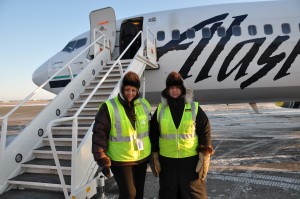
Alaska customer service agents Heidi Tokar (left) and Julie Bilbey (right), of Bethel, are dressed in a typical winter-weather gear for this remote area of Alaska.
Meet Bethel, Alaska. The town is located about 340 miles west of Anchorage and about 40 miles inland from the Bering Sea. There are only ten miles of paved roads and none connect to any highway. Roads made of ice and snow mobile trails are what connect to over 50 Native Alaskan villages in the region.
With the lack of solid ground transportation, aviation is very important to the town of less than 6,000 people. Even though the population is small, it is a major hub for air travel in the state. “It may be little, but it’s mighty,” says Christine Klein, Deputy Commissioner of Aviation for the state of Alaska. Aviation is a much larger part of the economy in Alaska than other states, accounting for one in every 10 jobs in the state and $3.5 billion in revenue.
Bethel Airport (BET) is the third busiest airport in the state, behind Fairbanks and Anchorage. The airport has two runways: One is paved and 6400 feet in length (for comparison, Seattle-Tacoma International Airport’s largest runway is almost 12,000 feet long) and one that is gravel and only 1,860 feet long.
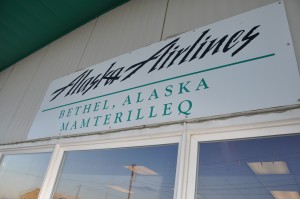
Signage at Bethel Airport
From June 2006 to June 2007, the airport had 122,000 aircraft operations, which is an average of 334 per day. During that time, there were 232 airplanes based at the airport: 90% single engine, 7% multi-engine, 2% helicopters and 1% military. Now, that is a lot of aviation for a town so far out in the middle of nowhere.
Alaska Airlines, who have 27 employees at the airport, proudly has a strong relationship with Bethel and the surrounding area. They fly round-trip flights between Bethel and Anchorage three times per day using their Boeing 737-400’s and Combis. Alaska Airlines provides important connections for passengers and cargo for Bethel residents and the rest of the world.
Alaska Airlines does much more than just fly in and out of the airport. The airline also supports local aviation and promotes careers in aviation. Recently the airline donated $15,000 to the Yuut Yaqungviat Flight School, which will will help local residents, the majority of whom are Native Alaskans, obtain their pilot, airframe and power plant mechanic licenses.
Founded in 2000, the flight school has a high placement rate for students who complete the two-year private pilot certificate program. Of 25 students who finished the program, 16 are actively working as pilots for Yute Air, Grant Aviation, Frontier Alaska, Hageland Aviation and other airlines. “Historically, a revolving door of professionals leave the Bethel area. This outmigration is a loss of potential revenue for the region,” says John Amik, co-director of the school. He continued, “Yuut Yaqungviat has helped young adults capture a sense of purpose, hope and self-respect.”
Alaska is hoping this assistance will not only help Native Alaskans find careers in aviation, but also help them get jobs with Alaska Airlines. “We would very much like to see more Native Alaskan pilots working their way into our cockpits,” said Bill MacKay, Alaska Airlines’ senior vice president.
If you live in an area where Alaska Airlines doesn’t fly: It is based out of Seattle, WA, flies over 115 Boeing 737’s to about 90 destinations in the US and Mexico, and of course has quite a few flights to Alaska. If you are interested in connecting with Alaska Airlines, be sure to follow their Twitter, Facebook or YouTube channel.
connect | web | twitter | facebook |
Images from Alaska Airlines





